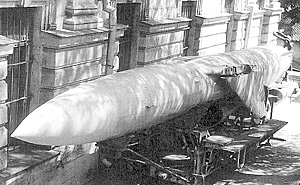 New Information and New Understanding
New Information and New Understanding
P-6 Progress Missile
Recent information from Russian authors like Moroz, Popsuevich, Shirokorad, Kuzin, Nikolskiy, and others are continuing to expand and clarify our understanding of these Soviet-era weapons. This new information requires several changes to the annex data, and to the rules themselves.
Command Guidance for Early ASCMs
Early in the Cold War, the Soviet Union saw threats all around them. From the seaward flanks, they saw the U. S. Navy’s amphibious assault capabilities that had been amply demonstrated in the Korean conflict. They also perceived a significant threat from aircraft carriers, particularly the new Forrestal class and her nuclear-capable aircraft just then entering service.
The Soviet Navy knew it could not defeat the U. S. Navy by traditional means, so they turned to new technology. Soviet engineers combined the high speed of the jet engine with a radar guidance system to create a fast, smart, unmanned kamikaze -- the anti-ship cruise missile (ASCM) .
Numerous missile programs were started in the mid-1950s, and within five years the Project 183R [Komar] and Project 205 [Osa I] class missile cutters, armed with the P-15 Termit [SS-N-2A Styx], entered service with the Soviet fleet. These small ships were produced in large numbers, and their missiles could inflict serious damage.
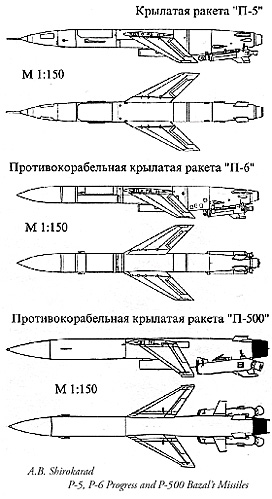 These missiles could deal with the amphibious threat, but what about the carriers? These fragile missile boats had to get very close to the target (25 nm) to fire their missiles. It was highly improbable that a small craft would survive a carrier battle group’s defenses. A longer reach was needed. That implied an autopilot using an inertial guidance system to keep the missile on course. Unfortunately, Soviet inertial navigation systems were still based on German designs, and these weren’t accurate enough to handle a moving target.
These missiles could deal with the amphibious threat, but what about the carriers? These fragile missile boats had to get very close to the target (25 nm) to fire their missiles. It was highly improbable that a small craft would survive a carrier battle group’s defenses. A longer reach was needed. That implied an autopilot using an inertial guidance system to keep the missile on course. Unfortunately, Soviet inertial navigation systems were still based on German designs, and these weren’t accurate enough to handle a moving target.
The answer for ship-launched missiles was to was to develop a sophisticated “reconnaissance-strike complex” (a Russian term) with a man-in-the-loop navigation system to allow long-range, over-the-horizon engagements. Missile-armed bombers had it a little easier, since they could get a clear radar line of sight to the target and lock the missile’s seeker on the target before launch.
Since the first edition of Harpoon, the Soviet Progress [SS-N-3 Shaddock] and Bazal't [SS-N-12 Sandbox] ASCMs have been listed as having inertial guidance with mid-course update and terminal active radar homing. While we've known about the guidance radars associated with these missiles, their role was unclear. An inertial guidance system with terminal homing is told the target’s approximate location (detected or deduced) by the firing ship. After the missile has traveled a preplanned distance, it uses its terminal seeker to find the target’s exact position and then home in. We assumed the radars were used for mid-course guidance to help adjust the missile’s course after launch. Actually, they are not just radars per se, but also data link antennas. This allows a human operator to control the missile’s seeker and navigation.
The Progress [Shaddock] ASCM family was Russia’s first generation of long-range antiship missile. The P-6/P-7 [SS-N-3c] and P-35 [SS-N-3b mod 1], with ranges in excess of 150 nm, would have to be controlled by a human operator if they were to have any chance of even finding the target. The missiles actually use a form of command guidance combined with a terminal active homing seeker. A guidance radar like the Binom [Scoop Pair] or Argument [Front Door] controls the missile inflight, guiding it toward a target that had been detected by the firing vessel’s organic sensors or by an aircraft.
5. 3. 1a Command Data Link Guidance with Terminal Homing (CDL/TARH)
This is similar to Command guidance (5. 3. 1) with some additional capabilities. The firing vessel must have a radar line of sight to the missile while it is inflight.
For over-the-horizon engagements, aircraft with the Uspekh [Big Bulge] radar would downlink their radar image to the firing platform, which can then use that image to designate a target and guide the missile towards it. Since these missiles do not have a reliable inertial guidance mode, missiles with this guidance system cannot be fired in the BOL mode. They must be fired at a target that has been detected.
Once the missile is within detection range of its homing system, the operator orders the weapon to use its terminal homing seeker to take over and attack the target. In addition to sending guidance signals to the missile, the missile also sends the radar image from its seeker back to the ship. In other words, the launching vessel can literally see what the missile sees. This means that the player does not have to randomly determine which ship is attacked, rather the player assigns each missile to a particular target.
If the radar signal is interrupted or turned off for any reason, the missile reverts to a backup inertial system. This will guide the missile to the last known position of the target, but because if its inherent inaccuracy, the chance of a hit is halved. A major disadvantage of this system is that a firing ship is limited in the number of missiles that it can control at one time. This depends on the number of guidance channels the radar has. The requirement to have radar line of sight, as well as the limitation on the number of missiles being controlled significantly affects the firepower of Soviet warships equipped with these older missile systems. The guidance radars associated with the Progress missiles, along with the number of control channels, are listed.
In addition to the control channel limits for each guidance radar, the P-6/P-7 and P-35 missile seekers only have a total of 12 separate guidance channels. This means that only 12 Progress missiles can attack the same formation at the same time without some of the missiles interfering with each other. If there are 12 P-6/P-7 and P-35 missiles in the air, any additional missiles launched will immediately revert to its backup inertial mode. Each additional missile launched will also cause one of the missiles already in the air (roll randomly) to also go stupid and crash.
Data Annex Mods:
Change the P-6 [SS-N-3b ], to P-6/P-7 [SS-N-3c ], and P-35 [SS-N-3c ]to P-35 [SS-N-3b mod 1]. Change the missile guidance from I/M/TARH to CDL/TARH.
Note: The P-5 Pityorka’s [SS-N-3a] guidance remains unchanged. It is an inertially-guided strategic land attack missile with a nuclear warhead.
The Soviets recognized the limitations of the Progress missile system, in particular its reliance on the command data link and the need for a forward observer. This made it difficult to use because the different units had to coordinate their movements while searching for a hostile, and possibly dangerous target. They immediately started working on a follow-on missile. They developed a better inertial navigation system, and they developed the Legenda satellite reconnaissance system to supplement the long-range aircraft and helicopters, since they were vulnerable to NATO air defenses.
The P-500 Bazal't [SS-N-12 mod 1] is similar in appearance and size to the P-35 Progress, but the P-500 has a longer range and is faster, basically everything the Soviets had originally wanted in the Progress missile. With a reliable inertial navigation system, the P-500 can be fired in BOL mode. However, the Soviets recognized the advantages of the command data link and retained this feature in the P-500. Therefore, a player does not have to randomly determine which ships are attacked by the missile salvo;each missile can be assigned to a particular target.
The Bazal't missile also introduced the first digital computer, which increased the number of control channels in both the Argon guidance radar and the total number of missiles that can attack the same target at the same time. While we do not have information on the exact number of channels for the Bazal't/Argon system, it is estimated to be double that of the Progress/Argument system. Thus, a single Argon radar can control up to 16 missiles at one time, and a total of 24 missiles can attack the same formation without interfering with each other. If more than 24 Bazal't missiles are fired at the same time, rather than missing automatically, the extra missiles revert to BOL mode.
After the P-500 Bazal't system was fielded, the Soviets went back and modified the P-35 [SS-N-3b mod 1] to incorporate some of the advanced features. The P-6/P-7 missile was not updated, because the Soviet Navy chose instead to modify Echo II SSGNs to carry the P-500. This modification included the fitting of the Tsunami [Punch Bowl] data link receiver that allows the Echo II mod class to receive signals from the Legenda satellites, as well as an airborne forward observer. The P-35M or Progress-M uses the 3M44 missile, which also has a reliable inertial navigation system and retains the command data link. While there is no information on any changes to the Binom guidance radar, we assume that it has been upgraded to the same performance as the Argument system.
Data Annex Mods:
Change the 3M44 [SS-N-3d ], to P-35M [SS-N-3b mod 2 ].
Change the P-500 Bazal't [SS-N-12] to P--500 Bazal't [SS-N-12 mod 1 ].
Change missile guidance from I/M/TARH to I&CDL/TARH.
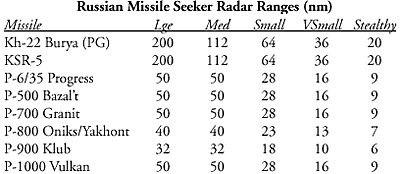 5. 3. 14. 3 Russian Long-Range Missile Seekers
5. 3. 14. 3 Russian Long-Range Missile Seekers
We have always treated Soviet missile radars in Harpoon as short-ranged terminal seekers, exactly like the ones fitted to all Western antiship missiles. New information indicates that the radar fitted to some Soviet missiles have ranges measured in the hundreds of miles.
In one case, the Kh-22 Burya [AS-4 Kitchen ], the seeker is locked onto the target before launch, which by necessity means that it has a range at least as great as the range of the missile.
In others, like the P-700 Granit [SS-N-19 ], the missile’s seeker is turned on some distance from the target, as one method of locating its target. In many cases, the missiles actually have two different radar frequencies that the seeker uses, one for searching and another for terminal homing. Once the target is located by the search mode, the missile loads the target’s location into its inertial guidance and then turns the radar off until the terminal phase. Target size does not have a great effect on the range at which a Western terminal seeker will pick up its target, typically 7-15 nm. However, a target’s radar signature will affect the much longer-ranged missile seekers. A missile will only lock on a target that has been detected, and once locked on, cannot change targets. If a missile has a long-range seeker, it will be listed in the remarks for that weapon. The seeker and its ranges will be also listed in Annex L, Airborne Radars. The table lists the missile seekers affected and their respective ranges.
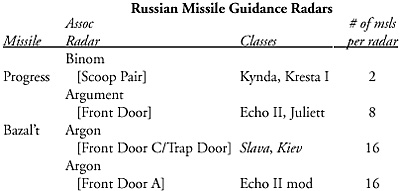 Russian Missiles with “Dual guidance”
Russian Missiles with “Dual guidance”
Several Russian missiles, like the 3M-80 Moskit [SS-N-22 ], are listed in many sources as having dual passive radar homing (PRH) and inertial guidance, along with an active terminal seeker. While missiles with this dual guidance capability can use PRH and inertial guidance, they use them separately, and the Russians consider PRH to be the primary guidance mode.
5. 3. 11a PRH or Inertial Guidance.
Missiles with this type of guidance can be given both a course and an enable point, and the player can also designate a radar signal for the missile to attack. If the missile never detects the designated signal, or if the hostile signal disappears, the seeker reverts to inertial guidance.
Even if the hostile radar signal continues, when it reaches its target the missile will switch to its terminal seeker to make its attack, either TARH or TIRH as fitted. At no time in the process is the seeker using true dual-mode guidance, where the seeker combines the data from both sensors.
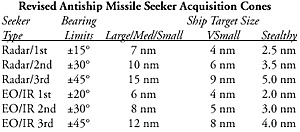 Multi-Channel Guidance
Multi-Channel Guidance
The newest generation of Soviet ASCMs is described by the Russians as having “multi-channel” guidance. It uses an intelligent seeker to choose the best of the several guidance types available to it.
5. 3. 14. 4 Multichannel Guidance (MCh)
This type of guidance chooses between different seeker modes as it searches for a target. It still needs a terminal seeker, e. g., MCh/TARH. The missile can be guided by one of several different methods as it closes on the target. Moreover, it can choose between them without human direction and switch modes as needed. These include Passive Radar Homing, Active Radar Search, and Inertial.
The player launches the missile either at a detected target or specifies a course and an enable point where the missile’s active radar seeker will begin searching. A player can also tell the missile’s passive radar seeker to look for a specific hostile radar.
After launch, the missile will listen for the specified radar and if it detects the radar, the missile will begin to home in on it. If the missile doesn't detect the radar by the time it reaches its enable point, it will automatically search with its radar seeker (see long-range radar seekers, above). The missile will search until it detects a target, then loads that location into its inertial guidance and turns its seeker off until the turn it reaches its target. The most advanced feature of the multi-channel guidance system, however, is the scout mode.
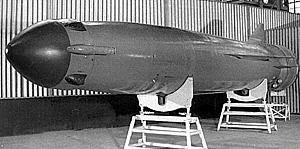 Scout Mode
Scout Mode
Advanced Soviet missiles like the P-700 Granit [SS-N-19 Shipwreck] (at right)and the P-1000 Vulkan [SS-N-12 mod 2] can pass information on to other missiles in the same salvo as they proceed toward a target. They can also communicate with other missiles in the salvo, coordinating their attacks.
5. 3. 14. 5 Scout Mode.
When a salvo of missiles with scout capability is fired, one missile (the scout) will automatically search for the target while the rest remain electronically silent and concealed.
This means that the scout, which can be fired up to one minute (two Engagement Turns) earlier than the rest, will use its active radar (see long range seekers above), or if the missiles have more than one flight profile, will fly at the highest altitude to maximize the chance for an ESM detection. If the scout detects a target, it will send the information to the other missiles in the salvo. The scout will also allocate each missile of the salvo so that they are properly distributed among the available targets.
This function is an automated version of the command data link, where a human operator chose the target for each missile in the salvo. One scout missile can provide guidance and attack information for up to 24 missiles in a salvo. If a scout missile is shot down, another missile from the salvo will automatically take over the scouting function.
Data Annex Mods:
Change P-1000 Vulcan [SS-N-12 mod 1] to P--1000 Vulcan [SS-N-12 mod 2 ].
Change P-700 Granit and P-1000 Vulcan guidance from I/M/TARH, to MCh/ TARH.
Missiles With Their Own Defenses
Reports have been published of some later missiles being fitted with defensive ECM to disrupt defending fire control radars, and of some fitted with armor or having “titanium construction, ” which is supposed to give them some ballistic protection.
While titanium can be used as armor, the added weight needed for effective defense against high-speed fragments is not consistent with the increased range also claimed for these missiles. It is more likely that the titanium is being used because of its lighter weight, which contributes to the extended range.
Revised Antiship Missile Seeker Acquisition Cones
Note: This table replaces the one on page 5-6 of the Harpoon 4.1 rules and reflects new information, as well as the work that went into the simplified radar model that was published in Naval SITREPs #24 and #25.
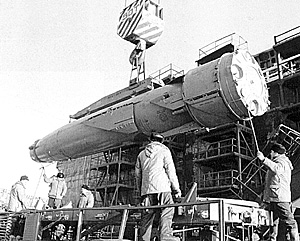 Pictures of the P-700 Granit being unloaded from the salvaged Kursk.
Pictures of the P-700 Granit being unloaded from the salvaged Kursk.
6. 4. 1. 7a. Missiles with Defensive ESM
If a missile is fitted with defensive ECM, it will be listed in the remarks for that weapon along with the generation of the jammer. Use the jammer’s generation to find the appropriate modifier on the Air-to-Air Combat Table when air or surface units engage the missile.
Multiple Flight Profiles
Many early Soviet ASCMs used a terminal dive from high altitude to reduce the defenders' chance of shooting it down. Approaching at high altitude, the missile would start a steep, high-speed descent just as it reaches the edge of the defenders’ defensive envelope.
Aegis and the New Threat Upgrade for non-Aegis ships were designed to neutralize this advantage. Ships fitted with these systems could engage the missiles without penalty, and the Russians knew it. Instead of sending missiles in at high altitude, which allowed them to be easily detected, the Russians developed missiles that could travel at supersonic speeds at very low altitudes. Since the air at low altitudes is dense, reducing both speed and range, they added a high-low flight option. This allowed it to travel farther and faster, but only until the missile nears the target. At that point, it drops down to very low altitude to make its attack.
Three missiles, the P-700 Granit, the P-900 Oniks/Yakhont, and the P-1000 Vulkan all can fly either a High-VLow or a VLow-VLow flight profile.
Air-Launched Missile Guidance Changes
The Kh-20 [AS-3 Kangaroo] has been listed in Harpoon as having inertial guidance. This is incorrect. It is actually command-guided for most of its flight. When the missile is 40 nm from its target, the operator locks the location into the missile’s inertial guidance unit, which takes over for the last two and a half minutes of flight. The Kh-20 is a nuclear land-attack missile, designed to hit stationary targets, but early inertial guidance units had drift rates of at least one nm per hour of flight. It takes a Kh-20 about 20 minutes to fly to its maximum range, and thus could be as much as 1/3 of a mile (670 yards) off target. Compare this to the drift from two and a half minutes of flight, which results in an error of about 85 yards.
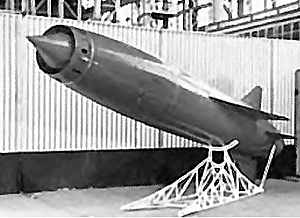 A P-700 Granit in flight configuration. (NPO Mashinostroeniya)
A P-700 Granit in flight configuration. (NPO Mashinostroeniya)
This change also means that the missile can now be effectively employed against surface ships, or at least against formations. As long as the controlling plane can see both the target ship and the missile on its radar when it locks the missile into its inertial mode, the ship will have only two and a half minutes' movement before the missile hits. Even at 30 knots, a ship can only move 2,500 yards away from the aim point, far too close to a nuclear detonation. If a launching plane aimed at one of the lead ships in the formation, it could bet on putting its weapon somewhere close to the center.
The Kh-22 Burya [AS-4 Kitchen]
It has always been listed in Harpoon as having I/TARH guidance. We've now found out that there were several different models of the Kh-22, with successively improved seekers. The first version, the Kh-22 PG, which IOCed in 1967, has only Active Radar Homing. In other words, it is locked onto its target before launch. This may create a problem if the player wants to attack a ship with a smaller signature. While the Kh-22’s seeker will lock onto a large target, like a carrier, near maximum launch range, the plane will have to close if it wants to pick out an escort ship, which may expose it to the formation’s defenses. Its PG seeker is listed in Annex L, Air Radars. Later versions of the Kh-22 (Kh-22M, 1974, and Kh-22N, 1976) did incorporate an inertial guidance unit as well as an active seeker for terminal guidance.
 P-800 Oniks/Yakhont in flight. Note the similarity to the P-700 Granit. (NPO Mashinostroeniya)
P-800 Oniks/Yakhont in flight. Note the similarity to the P-700 Granit. (NPO Mashinostroeniya)
Missile Annexes:
Add the following abbreviations to possible Annex D remarks:
ECM#-Missile fitted with radar jammer, number indicates generation.
Example: The P-1000 Vulkan is an ECM2 (2nd Gen Jammer)
Thanks to Peter Grining and Vasiliy for their assistance in preparing this article.
Sources
JEDONLINE
Jane’s Navy International
International Air Power Review
personal.inet/cool/foxfour/sovmis/sovmis-ss-n.html
The Soviet Navy, V. P. Kuzin & Nikolskiy
The Encyclopedia of Rocket Armaments: 1817-2002, A. B. Shirokorad
World Naval Weapons Systems, Friedman
Combat Fleets of the World, Baker
Soviet Long Range and Naval Aviation Missiles, Moroz &Popsuevich
BT
Back to The Naval Sitrep # 26 Table of Contents
Back to Naval Sitrep List of Issues
Back to MagWeb Master Magazine List
& copy Copyright 2004 by Larry Bond and Clash of Arms.
This article appears in MagWeb.com (Magazine Web) on the Internet World Wide Web.
Other military history and related articles are available at http://www.magweb.com